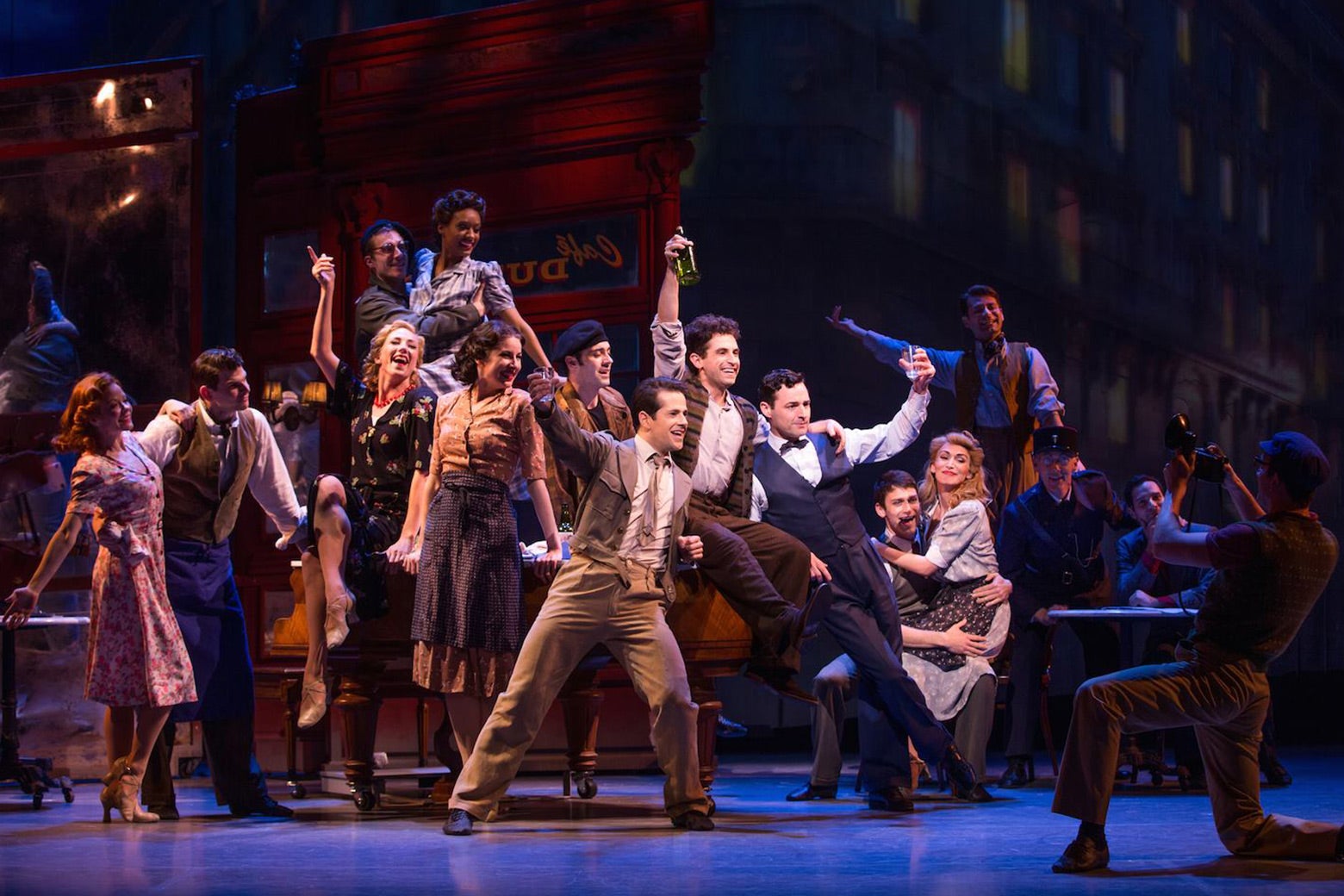If you’re expecting An American in Paris: The Musical to be a copycat of the movie that inspired it, you can kiss those expectations goodbye as swiftly as the enormous swastika banners come tumbling down onstage. From the very beginning, it’s clear that the city we see in the production is no idealized Paris where a cuddly Gene Kelly tap-dances in the streets for the amusement of little children. This is a gloomier, postwar Paris that has survived a Nazi occupation, one whose residents are still dealing with the lingering effects.
The stage musical, which made its way from Paris to Broadway and the West End and is now screening in select theaters, is inspired by the lush MGM musical An American in Paris, which starred Gene Kelly as Jerry Mulligan, an ex-GI who stays behind in France as a painter after World War II. There, he falls for French shopgirl and aspiring ballerina Lise, who is already all but engaged to Jerry’s new friend Henri—in the new stage version, the son of wealthy industrialists, who dreams instead of a career as a song-and-dance man.
It’s details like those that set this An American in Paris apart from its cinematic inspiration. As joyful as Kelly’s movie is to watch, it doesn’t have much in the way of plot—and it doesn’t really need it, since what little there is does a perfectly fine job of stringing together the movie’s Gershwin songs and dreamy Technicolor sequences, including the famous 17-minute ballet that the movie concludes with.
On stage, the extended ballet sequences are still there, choreographed this time by Christopher Wheeldon, and they are just as exquisite, especially as performed by stars Leanne Cope and Robert Fairchild, who were both nominated for Tony Awards during the show’s Broadway run.* (The version playing in theaters reunites both performers in the West End production instead.) The same can be said for Bob Crowley’s costumes and set design, which often echo the bold primary colors of the movie—although they sometimes slip into moodier palettes, as when he re-creates a blackout at a French café that causes the rattled patrons to panic.
That’s appropriate, because the musical’s book writer, Craig Lucas, was not content with the original movie’s escapism, giving the characters more substantial backstories and shifting the setting to immediately after the end of the war, with all the consequences that entails. Lise, for instance, is made explicitly Jewish, and her loyalty to Henri stems as much from dutiful gratitude toward his family for hiding her from the Germans during the occupation as it does from love. She gains an additional romantic interest, too, in Jerry’s friend Adam, a composer played in the original movie by Oscar Levant and in the stage musical by David Seadon-Young, whose accent is impossible to place to the point of distraction.
Adam, Jerry, and Henri, the movie’s “three musketeers,” are all blissfully unaware, for a time, that they’re in love with the same woman. As in the movie, Jerry is also entertaining a flirtation with Milo, an American patroness who is interested in him for more than his art. (A scene in which she tricks Jerry into coming alone to her apartment with the pretense of a party is right out of the Weinstein playbook.) Henri, meanwhile, is not just in show business but very likely “in show business” too, his closeted interest in showmanship a metaphor for his own sexuality—and a bit of a running joke among the other characters. His mother, in particular, is afraid of what people will say if they find out, still in the mindset of the occupation even after the Nazis have left.
“Artists have a responsibility to show the dark underbelly to life,” insists Adam, also Jewish and staying in the city rent-free, thanks to the guilt of the residents. “Don’t listen to him,” replies Henri. “Paint what you love. Make them pretty.” The musical eventually settles for a kind of in-between, retaining a few essential songs from the movie, including “I Got Rhythm” and “ ’S Wonderful,” while padding the rest of it by borrowing other Gershwin songs, like “Who Cares?” from Of Thee I Sing and “Liza (All the Clouds’ll Roll Away)” from Show Girl. That last one requires some contortions to make it fit; Jerry straight-up renames Lise, a woman he’s just met, insisting that “Liza” is happier.
Lise is not quite as fleshed-out in the script as some of the other characters, but Cope does a lot with what she’s given, and her dancing often says what the dialogue doesn’t. She does have one memorable line, shouting at Jerry that life “isn’t like your American movies.” It’s certainly true of the musical, which isn’t an escape the way the movie that inspired it is; the angst of a city recovering from fascist occupation is probably not the distraction you’re looking for from the news. But if it’s sheer optimism you want, well, there’s always Gene Kelly for that.
Correction, Sept. 24 , 2018: This post originally misstated that Robert Fairchild won a Tony Award for his role in An American in Paris on Broadway. He was nominated for Best Performance by a Leading Actor in a Musical, but did not win.
